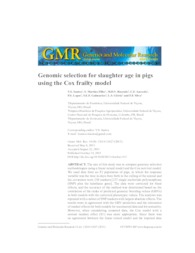Genomic selection for slaughter age in pigs using the Cox frailty model.
Genomic selection for slaughter age in pigs using the Cox frailty model.
Autoria: SANTOS, V. S.; MARTINS FILHO, S.; RESENDE, M. D. V. de; AZEVEDO, C. F.; LOPES, P. S.; GUIMARAES, S. E. F.; GLORIA, L. S.; SILVA, F. F.
Resumo: The aim of this study was to compare genomic selection methodologies using a linear mixed model and the Cox survival model. We used data from an F2 population of pigs, in which the response variable was the time in days from birth to the culling of the animal and the covariates were 238 markers [237 single nucleotide polymorphism (SNP) plus the halothane gene]. The data were corrected for fixed effects, and the accuracy of the method was determined based on the correlation of the ranks of predicted genomic breeding values (GBVs) in both models with the corrected phenotypic values. The analysis was repeated with a subset of SNP markers with largest absolute effects. The results were in agreement with the GBV prediction and the estimation of marker effects for both models for uncensored data and for normality. However, when considering censored data, the Cox model with a normal random effect (S1) was more appropriate. Since there was no agreement between the linear mixed model and the imputed data (L2) for the prediction of genomic values and the estimation of marker effects, the model S1 was considered superior as it took into account the latent variable and the censored data. Marker selection increased correlations between the ranks of predicted GBVs by the linear and Cox frailty models and the corrected phenotypic values, and 120 markers were required to increase the predictive ability for the characteristic analyzed.
Ano de publicação: 2015
Tipo de publicação: Artigo de periódico
Unidade: Embrapa Florestas
Palavras-chave: Censured data, Dado censurado, Mixed model, Modelo mixto, Polimorfismo, polymorphism
Observações
1 - Por padrão são exibidas publicações dos últimos 20 anos. Para encontrar publicações mais antigas, configure o filtro ano de publicação, colocando o ano a partir do qual você deseja encontrar publicações. O filtro está na coluna da esquerda na busca acima.
2 - Para ler algumas publicações da Embrapa (apenas as que estão em formato ePub), é necessário ter, no celular ou computador, um desses softwares gratuitos. Sistemas Android: Google Play Livros; IOS: iBooks; Windows e Linux: software Calibre.
Acesse outras publicações
Acesse a Base de Dados da Pesquisa Agropecuária (BDPA) para consultar o acervo completo das bibliotecas da Embrapa.

